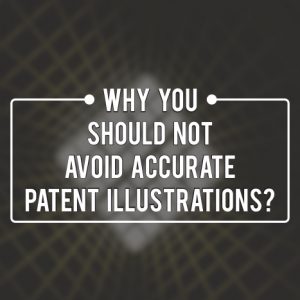Patent drawings are the illustrations of an invention an invention in a 2-D format. This is useful for a better understanding of the invention. Thus, patent illustrations are a necessary element of any patent application. During the drafting process, it becomes extremely important to represent the drawings of the invention efficiently. This is the reason why the theoretical specification must be coupled with patent drawings and not just textual description alone. Most of engineering and design patent applications need patent illustrations to explain the scope of their claim. Patent drawings are also really helpful during the cases of patent infringement.

USPTO Requirements of Patent Drawings
According to the United States Patent and Trademark Office (USPTO), it is compulsory for the applicant to attach provide an inclusive and thorough patent illustration in order to comprehensively explain various facets of the invention. Also, it is mandatory to submit at least one patent drawing along with the patent application. However, there is no such compulsion for chemical compounds. USPTO provides a time period of 2 months for patent drawings submission. The patent illustrations can be drawn for utility, electronic, medical, mechanical, etc.
Also Read: The Importance of Provisional Patent Illustrations – Patent Illustration Express
Types of Patent Drawings
Generally, there are two types of patent drawings:
- Design Patent Drawings: These patent illustrations are used to demonstrate the applications of an ornamental design to a product. Not only do they aid in explaining the aesthetical design of the particular product, but also help in depicting texture, shape, and other surface properties of the product. Design patent drawings are mainly for patent applications related to furniture items, jewelry, and containers. Their life span is fourteen years with no need for a reference number.
- Utility Patent Drawings: Utility Patent Drawings explain various components or parts of a device, assembly, electrical circuit, or other system components. Along with this, they are also helpful in representing the working steps of an invention graphically.
Important Patent Drawing Rules
- Always use black and white for all the patent diagrams. India ink or any other equivalent ink works perfectly to ensure excellent drawing quality.
- Ensure that the illustration is to the scale even when reduced to two-thirds the size.
- Don’t forget to add identification details (invention’s name, inventor, and application number) above each illustration.
- Draw the patent diagrams on an A4-sized white paper of length 11 inches and width 8.5-inch. Make sure that the drawing paper is plain, not glossy, sturdy, and long-lasting.
- Prevent congestion and any superimposition of patent illustrations or excessive writing.
- Margins of 1 inch above and left, 3/8 inch on the right side, and 5/8 inch on the bottom part are essential.
- Make sure to add scan target points/cross-hairs/cater-corners.
- Numbering should be clear and larger than reference characters. Also, use the Arabic numeral system for numbering.
- Use leader lines and Arabic numerals to name the parts of the illustration.
- Do not label the parts of the drawing unless and until it is a block diagram or a flow chart.
- Use isometric or sectional view to demonstrate the mechanical assemblies.
- Use shading for a better representation of the product’s structure.
Also Read: Top 4 Interesting Patents – Patent Illustration Express
Significance of Patent Drawings
Using patent drawings is mandatory according to USPTO. So, the probability of rejection by USPTO is manifold in case you abstain from including patent illustrations. However, this should not be the only rationale behind adding meticulous patent illustrations in your patent applications.
- A patent application is not complete without a self-explanatory patent drawing. Also, a high-quality patent drawing in compliance with the USPTO rules will surely provide more accuracy to your patent application.
- Patent drawings will enhance the clarity of a patent application. Moreover, it will ease the application review process for the patent examiner. This will surely result in the expedition of the patent prosecution process.
- USPTO considers patent applications on a first-to-file priority basis. To take the best advantage of the feature, your patent application should contain quality patent illustrations.
- Along with the patent applications, these patent drawings can also be demanded by the USPTO’s patent examiner for clearing his doubts if they were not clear just by textual specifications.
Also Read: A Detailed Insight on Patent Drawing Rules – Patent Illustration Express
Our Patent Drawing Services
Patent Illustration Express has built up a large pool of expertise fluent in patent illustration services. Our IP Professionals team has great skill-proficiency and grasp at drawing quality patent illustrations for various fields ranging from biotechnology, chemistry, electrical engineering, mechanical engineering, and medical sectors. At Patent Illustration Express, we offer satisfactory, exhaustive, and intricate drawing services drew directly by credible IP professionals. We ensure to provide the best patent drawing services on a budget. Want to know more about our services? Visit us here.
Other Related Articles
Patent Portfolio and its Importance




